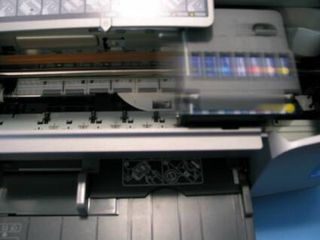Printing Your Own CDRs With Ink
Printing Your Own CDRs

Sometimes the best ideas for articles result from discussions of problems. Recently, I had such a discussion with Kyle Felstein of All American Computers at a LAN party where we were discussing the 'finer points' of air bubbles that sometimes develop under CDR labels. These air bubbles do not appear immediately, but often gradually develop over time. Even if you follow the directions for using these labels, changes in temperature that CDRs are exposed to can cause air bubbles to form between the CDR and the label surface. It is not due to a manufacturing problem with the label sheets or the application of the label by the user, but it stems from the manner in which labels are affixed to CDRs.
When air bubbles begin to form under the label there is little that can be done to resolve this. (Some people suggest using the head of a pin to poke a hole in the label surface, thus allowing trapped air to escape, so the label will again affix to the surface. Personally, we have not found this to be a good solution, since metal pins and CDRs don't mix well together.) Labels that are applied to a CDR are more problematic by nature due to the high speed of today's modern CD-ROM and DVD-ROM drives. When bubbles form under labels the bubbles can affect the balance of the CDR, which means that the CDR does not spin in a balanced manner in the drive. This can lead to read errors, and in rare cases, cause a CDR to shatter within the drive itself.
The world of CDR technology has evolved considerably in the past several years. This has resulted in companies developing CDR printers that can use either thermal or ink to print directly on the surface of a CDR. Normally, these high end CDR printer devices are designed for volume production and have not been very affordable for the general consumer. In addition, CDR printers require media that offers a thermal-ready or ink jet-ready surface to be printed on.
What if a common ink jet printer could be used to print directly onto the surface of a CDR? Of course, you would still have to use blank CDR media that offered an ink jet printable surface, but it would remove the adhesive CDR labels from the equation, which would resolve some of the problems associated with labeling CDRs. The use of ink from a typical ink jet printer should not upset the delicate balance of the CDR, and this should avoid potential problems associated with the use of adhesive labels. Since printer companies are using ink jet printers to print everything from banners to iron-ons and stickers, why not use them to print on the surface of CDRs?
After additional discussion with Kyle, he pointed out that Epson has designed several of their new printers to be able to print directly upon printable CDR media. This is not a noticeable feature that one would normally look for, as printing directly upon CDR media is not the primary reason that one purchases a printer. However, this printer solution has the potential to address the CDR problem as well as offering a significant feature that is above and different from the rest.
Due to past experience, I am always skeptical of new technology and features that always seem to be crammed into multipurpose devices so that it seems like an 'everything but the kitchen sink' device. These Epson printers were no exception, as they offer a variety of features. Kyle arranged for me to have a look at both the Stylus Photo 900, a lower end Epson model, and the Stylus Photo 960, a higher end model. Both printer models offer direct to CDR printing and come bundled with software from Epson to do so.
We put the 900 and 960 through their paces to determine whether a consumer oriented printer can serve as a CDR printer while at the same time making the process bearable without creating numerous CDR beverage coasters.
Stay on the Cutting Edge
Join the experts who read Tom's Hardware for the inside track on enthusiast PC tech news — and have for over 25 years. We'll send breaking news and in-depth reviews of CPUs, GPUs, AI, maker hardware and more straight to your inbox.
Current page: Printing Your Own CDRs
Next Page What Is The Difference Between The Epson Models 900 And 960?Most Popular

